“Happy families are all alike; every unhappy family is unhappy in its own way.” — Leo Tolstoy, Anna Karenina
Stanisław Zieliński was born on 6 April 1863, the third child and oldest son of the known children of Michał Zieliński and Antonina Ciećwierz. He married Marianna Kalota, daughter of Roch Kalota and Agata Kurowska, circa 1885, probably in Marianna’s home parish of Młodzieszyn. Unfortunately, most vital records for Młodzieszyn were destroyed, including all marriage records prior to 1889, which likely explains why their marriage record has not been found. The Zieliński family were ethnic Poles living in historically Polish lands that were at that time part of the Russian Empire. Like his father, Michał, Stanisław Zieliński was a gospodarz, which Shea and Hoffman define as a “farmer (one fairly well off, owning his own land), landlord.”1 Stanisław and Marianna made their home in Mistrzewice, where his parents were living, rather than in the nearby village of Budy Stare, where Marianna was born.
On 16 September 1886, Stanisław and Marianna welcomed their first child: a son, Franciszek. A second son, Antoni, was born on 6 May 1889. However, he only lived for a year and 5 months before passing away on 5 October 1890. Families were all too accustomed to high infant mortality in those days, so perhaps it was some consolation to Marianna and Stanisław that she was already pregnant with their third child as they buried little Antoni. Their third son, Piotr, was born on 4 May 1891, but his death was recorded in the parish books of Mistrzewice only one week later.
Little Franciszek had already turned six years old when his brother Józef was born on 10 October 1892. Two years later, on Christmas Eve, another brother, Szczepan, joined the family. Stanisław and Marianna welcomed two more sons, Władysław and Jan, on 20 March 1897 and 20 March 1899, respectively, and then three daughters were born: Władysława, on 25 June 1901, Marianna, on 14 September 1903, and Zofia, on 25 November 1907. Sadly, little Marianna lived for just two and a half months2 before she joined her brothers Antoni and Piotr in the parish cemetery.
In March of 1907, Franciszek decided to head out into the world and seek employment opportunities in America. A young man, 21 years of age, he had already completed three years of compulsory military service in the Russian infantry, which was a distasteful obligation for most Poles. It’s not clear what factors influenced him in his decision to leave his homeland, but at the end of March in 1907, Franciszek departed from the Port of Bremen, arriving at Ellis Island on 7 April 1907. He was bound for Buffalo, New York.
There is some evidence to suggest that Frank’s younger brother, Joseph, joined him in the U.S. circa 1909 and then returned to Poland prior to his “official” arrival in the U.S. in 1912. The best match for Frank Zielinski in the 1910 U.S. census was to a man who was boarding with Anthony and Mary Lapinski in Buffalo, New York, along with another boarder, Joseph “Rzolek,” — and one Joseph Zielinski, all immigrants from Russian Poland. In this document, Frank and Joseph Zielinski are reported to be ages 26 and 20, respectively, suggesting birth years of 1884 and 1890, making them both exactly two years older than expected for my relatives. Frank reported arriving in the U.S. in 1906, while Joseph reported arriving in 1909. (No good match for his passenger manifest circa 1909 has been located as of yet.) Both men were working in a foundry (possibly Lackawanna Steel Company), Frank as a molder and Joseph as a core maker. These occupations are interesting in light of the fact that Joseph reported his occupation as molder on the record of his 1915 marriage to Genevieve Klaus. Nonetheless, Zielinski is a very common Polish surname — so much so that the 1925 New York State Census shows a 35-year-old boarder named Joseph Zielinski living with the family of my great-grandparents Joseph and Genevieve Zielinski in North Tonawanda. When I asked my grandfather, John Zielinski, about that boarder, he remembered the man and insisted he was not a relative, it was just a crazy coincidence.
There is no evidence to suggest that Frank returned to Poland after his arrival in the U.S. in 1907. However, if the Joseph in the 1910 census is my great-grandfather, then he must have gone back to Poland some time after April 27, 1910 and then returned to the U.S. on 3 September 1912 on the S.S. Grosser Kurfürst, which is the date which corresponds to his arrival per his naturalization papers. The passenger described on this manifest is an incontrovertible match to my great-grandfather. On line 3, “Josef Zelinski” is reported to be a 20-year-old Pole from Russia whose last residence was “Mestanice,” and whose father, Stanisław Zelinski, was living in “Mistrzewice, Warsaw.” Joseph was headed to North Tonawanda, New York, and the second page reveals that he was specifically headed to his brother, Franciszek Zielinski at 7 Sawyer Avenue. His place of birth was recorded as something vaguely akin to “Mistrzewice.” Interestingly, Joseph’s answers to the questions about any previous travel to the U.S, support the idea that he was not in the U.S. previously, and it’s difficult to state with certainty that the Joseph Zielinski in the 1910 census is indeed the same man.
By 1915, Frank was boarding with the family of Joseph and Mary Brodowski at 65 7th Avenue in North Tonawanda and working as a laborer in the steel mill. His brother Joseph was similarly working in the steel mill while boarding down the street with the family of Peter and Bronisława Kwiatkowski at 44 7th Avenue in North Tonawanda — but not for long. On 5 October of that year, Joseph married 18-year-old Genowefa (Genevieve) Klaus.
Figure 1: Józef Zieliński and Genowefa Klaus, 5 October 1915, North Tonawanda, New York.
Joseph’s brother, Frank, seated on the bride’s left, was his best man (Figure 2).
Figure 2: Wedding party of Józef Zieliński and Genowefa Klaus, 5 October 1915. 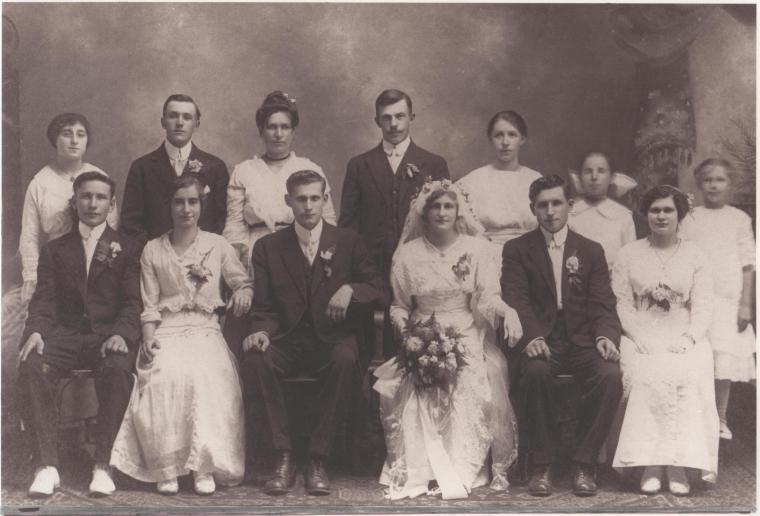
Genevieve was born in North Tonawanda to Andrzej and Marianna (née Łącka) Klaus, Polish immigrants from the Galicia region of the Austrian Empire. As Józek and Genia (Joe and Jenny, as they were called in English) settled into married life, however, his family in Poland was experiencing dark days. World War I was raging in Europe, and Mistrzewice, situated in the path of the advancing German army on its way to Warsaw, found itself in the midst of battle. The period from December 1914 through July 1915 witnessed the harshest devastation at the hands of both the Germans and the Russians. German soldiers stripped homes and farms in Mistrzewice, Młodzieszyn, and the surrounding villages of whatever materials they could repurpose for the building of fortifications and trenches. As the Germany army advanced, many Polish peasants became refugees, fleeing eastward in the hope of survival. However, as the Russian army retreated, they were ordered to “expel the ‘enemy’ nations within,” killing Poles, Jews, and other ethnic groups in keeping with the Tsarist policy of ethnic homogenization. It is estimated that 70,000 soldiers were killed on both sides during this battle of the Rawka-Bzura, some of whom were buried in the cemeteries in Mistrzewice and Młodzieszyn, and there are no good estimates for the number of civilian peasants from this area who were casualities of the war.
It was on August 13 of that year that Frank and Joseph’s youngest sister, 7-year-old Zofia, died. Her death certificate does not reveal her cause of death. Did she die of some childhood illness like her siblings? Was her death a direct cause of the war — being in the wrong place at the wrong time, a victim of a stray bullet? Or did her family try to flee the village, and she perished as a result of the typhus, cholera, typhoid, malaria, or dysentery that were prevalent among both soldiers and refugees? What is clear from her death record is that her death was not reported until 31 December 1915 because of the war (Figure 3).
Figure 3: Death record from Młodzieszyn for Zofia Zielińska, 1915.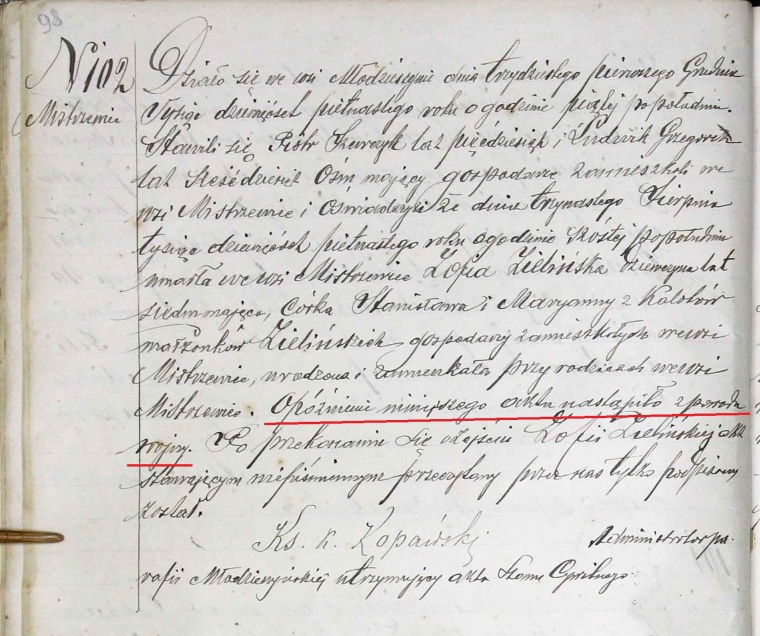 In translation, this document states,
In translation, this document states,
“#102. Mistrzewice. This happened in the village of Młodzieszyn on the thirty-first day of December in the year one thousand nine hundred fifteen at five o’clock in the afternoon. They appeared, Piotr Szewczyk, age fifty, and Ludwik Grzegorek, age sixty-eight, farmers residing in the village of Mistrzewice, and stated that, on the thirteenth day of August in the year one thousand nine hundred fifteen, at six o’clock in the afternoon, died in the village of Mistrzewice, Zofia Zielińska, a girl having seven years of age, daughter of Stanisław Zieliński and Marianna nee Kalota, the spouses Zieliński, land-owning farmers residing in the village of Mistrzewice; born and residing with her parents in the village of Mistrzewice. The delay in the registration of this act happened due to the war. After confirmation of the death of Zofia Zielińska, this document was read aloud to the witnesses but was signed only by Us. [Signed] Fr. K. Kopański, administrator of Młodzieszyn parish performing the duties of civil registrar.”
Just four months after Zofia’s death and two months after his son Joseph’s wedding in North Tonawanda, Stanisław Zieliński passed away on 23 December 1915.3 At the time of his death, his sons Szczepan, Władysław and Jan were 21, 18 and 16, respectively, and daughter Władysława was 14 years old. It’s not clear how, or if, the boys managed to avoid conscription into the Russian Army. Szczepan’s death record in June of 1916 mentions only that he was born in the village of Mistrzewice and was residing there with his mother (Figure 4).
Figure 4: Death record from Młodzieszyn for Szczepan Zieliński, 1916.4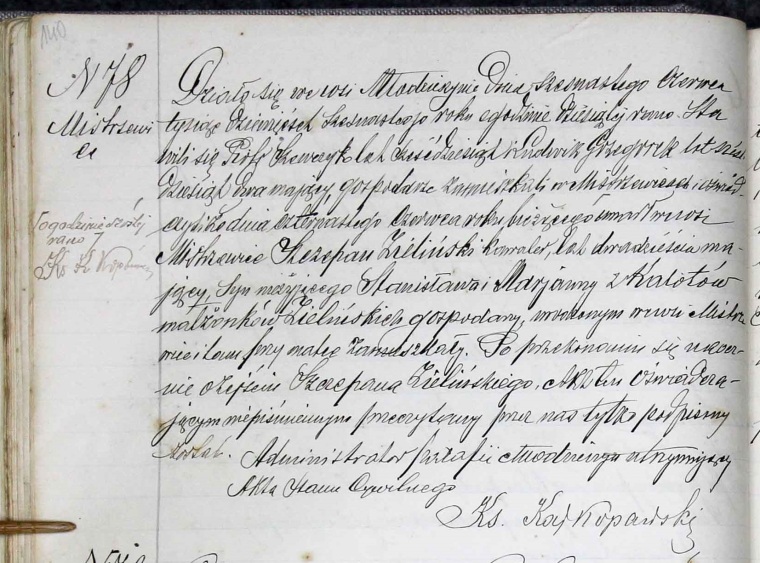 Translation:
Translation:
“#78. Mistrzewice. This happened in the village of Młodzieszyn on the sixteenth day of June in the year one thousand nine hundred sixteen at six o’clock in the morning. They appeared, Piotr Szewczyk, age sixty, and Ludwik Grzegorek, age sixty-two, farmers residing in the village of Mistrzewice, and stated that, on the fourteenth day of June in the current year, at six o’clock in the morning, died in the village of Mistrzewice, Szczepan Zieliński, bachelor, aged twenty, son of Stanisław and Maryanna nee Kalota, the spouses Zieliński, landowning farmers; born in the village of Mistrzewice and residing there with his mother. After eyewitness confirmation of the death of Szczepan Zieliński, this document was read to the illiterate witnesses and was signed only by us.[signed] Administrator of the parish of Młodzieszyn acting as civil registrar, Fr. Kaj. Kopański.”
Although no mention is made of military service, it is nonetheless possible that the Szczepan was fighting in the war. A genealogist friend in Poland explained that death records would sometimes state that the deceased was a soldier, and indicate what country he was killed in, but that it depended on the priest. Many priests were afraid to disclose such information. In the parish of Baranowo, he explained, a priest was killed by a Russian officer for singing the song, “Boże, coś Polskę” Many people lived in fear.
Meanwhile, in North Tonawanda, Joe and Jenny welcomed their first child, John Frank Zielinski (my grandfather), on 18 October 1916 (Figure 5).
Figure 5: John Frank Zielinski, circa early 1917.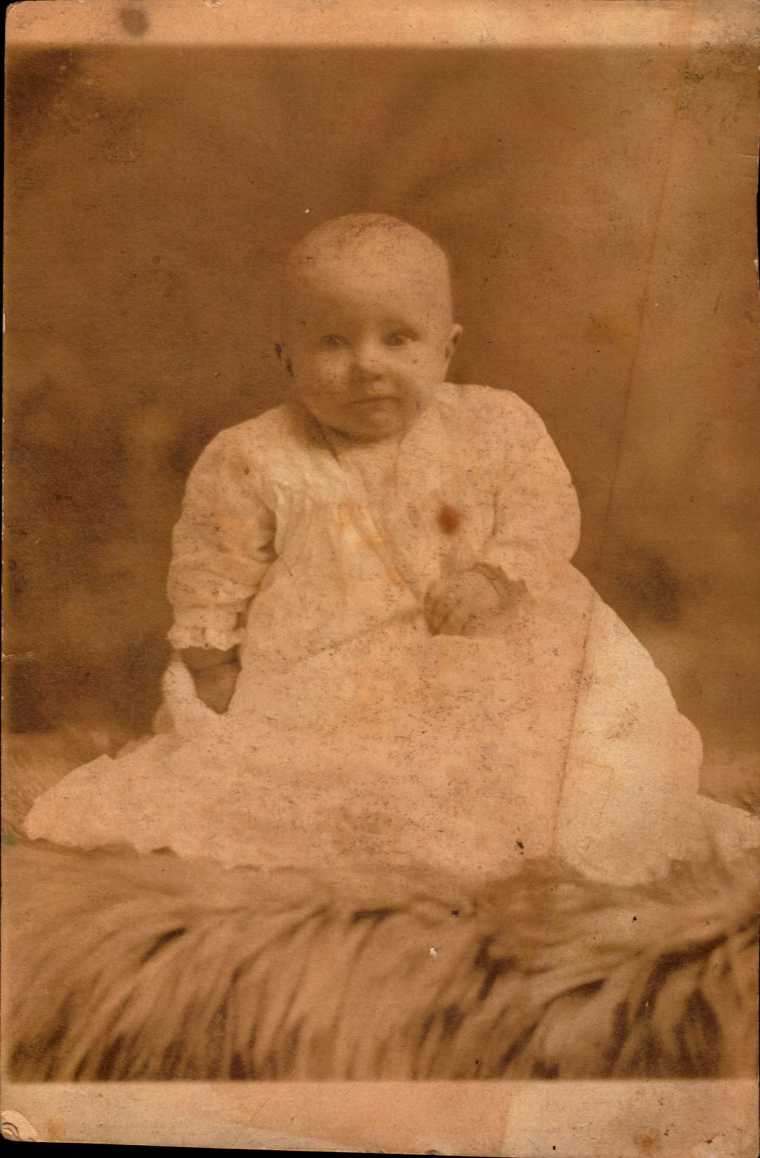
But while the family in North Tonawanda thrived and grew, the family in Mistrzewice continued to suffer, and on 13 April 1917, Joe Zielinski’s brother Jan died at the age of 18 (Figure 6).5
Figure 6: Death record from Młodzieszyn for Jan Zieliński, 1917.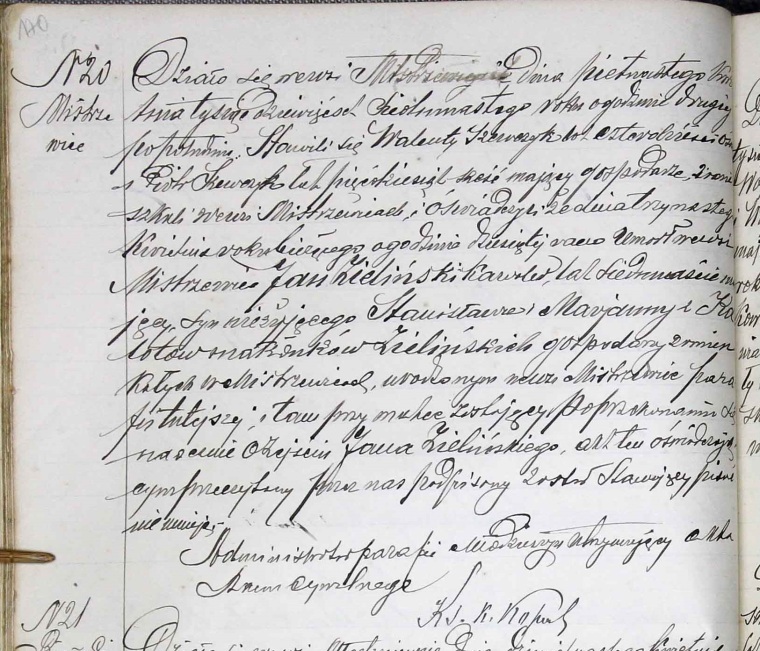
Again, no mention was made of the cause of death, and whether it was a direct or indirect result of the war. The record only states that he was born in the village of Mistrzewice in the local parish and was living there with his mother.
On 6 April 1917, the U.S. declared war on the German Empire, and in June of that year, Joseph and Frank were required to register for the draft. As resident aliens, they were supposed to be placed in Draft Class V: Exempt and Ineligible. However, local draft boards had the authority to assign draft classes on a case-by-case basis, and Frank Zielinski’s status as a single man with prior military experience and no dependents made him a desirable candidate for the draft, regardless of the fact that he was a Russian citizen. The particulars of Frank’s military story are an interesting tale in themselves (and a topic on which I’ve lectured previously), and deserve to be told in depth at another time. But as his service record indicates, Frank was inducted on 24 February 1918, and sent overseas on 7 April 1918 as a member of the 307th Infantry Regiment, Company C. Frank Zielinski was killed in action on 25 October 1918, shot through the head by a sniper’s bullet.6 The oldest son of Stanisław and Marianna Zieliński is buried in the Meuse-Argonne American Cemetery in Romagne-sous-Montfaucon, France, although available evidence suggests that he was never naturalized, and there is no evidence to suggest that he ever wished to be an American citizen (Figure 7).
Figure 7: Gravesite of Frank Zielinski.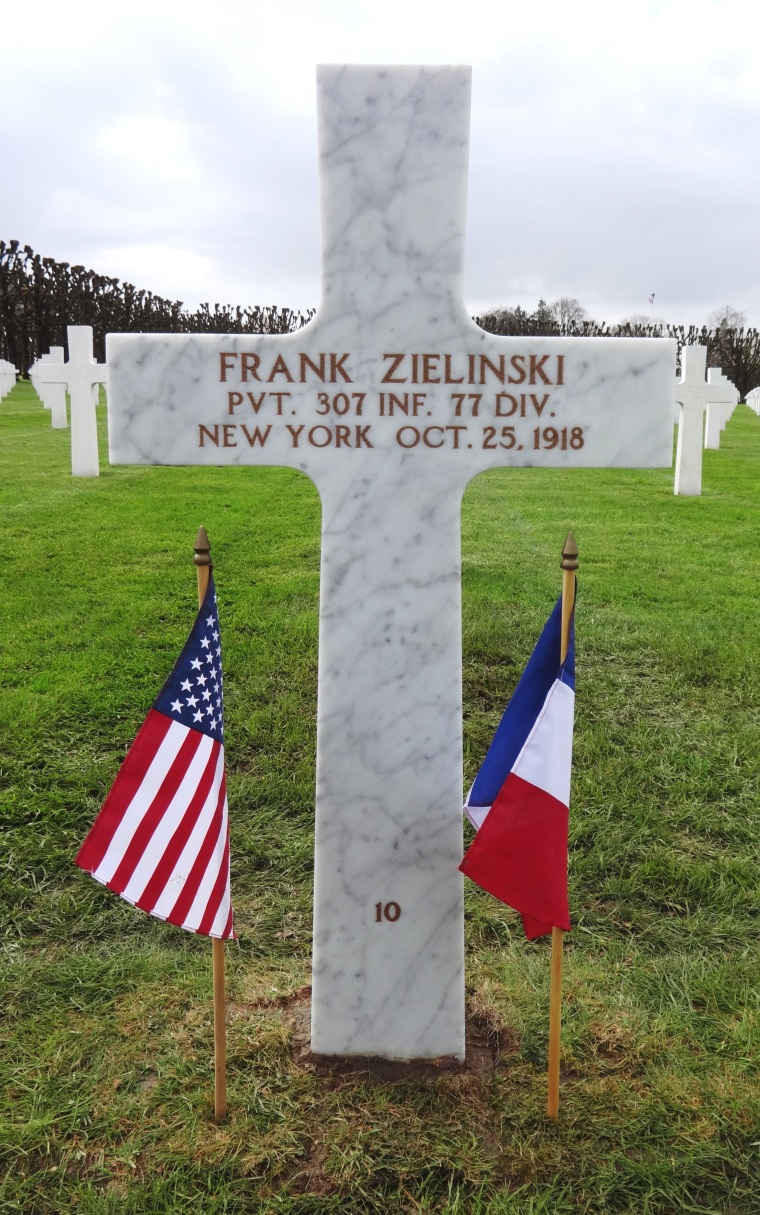
Joe and Jenny Zielinski’s second child, Frank Walter, was born on 2 September 1918, named after his uncle who was serving in the war. The following spring, Joseph Zielinski filed his Declaration of Intent to Naturalize on 18 March 1919. 7 His family in North Tonawanda was growing, and he must have felt that life in the U.S. was good. As further evidence of Joe’s intentions to remain in the U.S., correspondence with the U.S. Quartermaster General’s office, dated 13 March 1919, indicates that Joe wished to have his brother’s remains returned home for burial in North Tonawanda (Figures 8a and 8b), although he was concerned about the expense of shipping the body.8
Figure 8a: First page of letter from Joseph Zielinski to the Quartermaster General’s Office, dated 13 March 1919.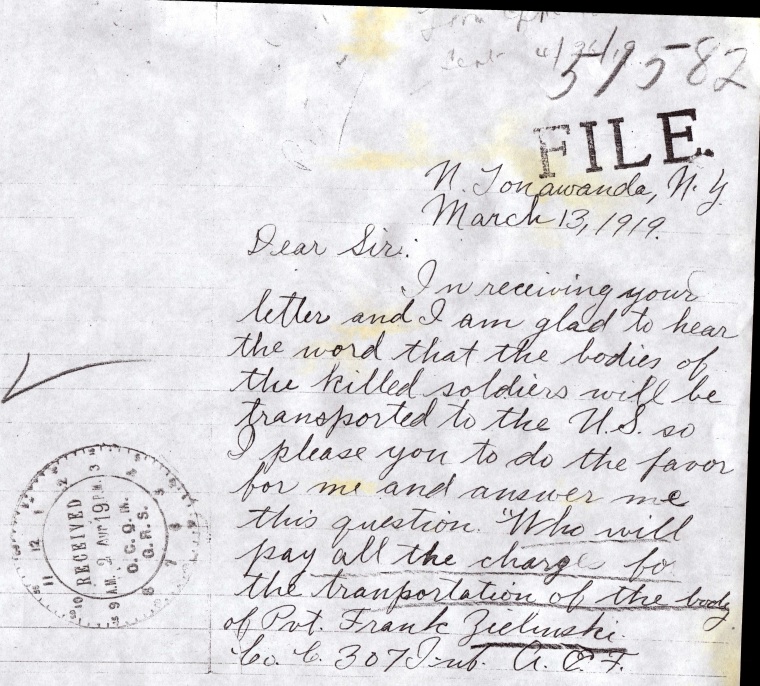
Figure 8b: Second page of letter from Joseph Zielinski to Quartermaster General’s Office.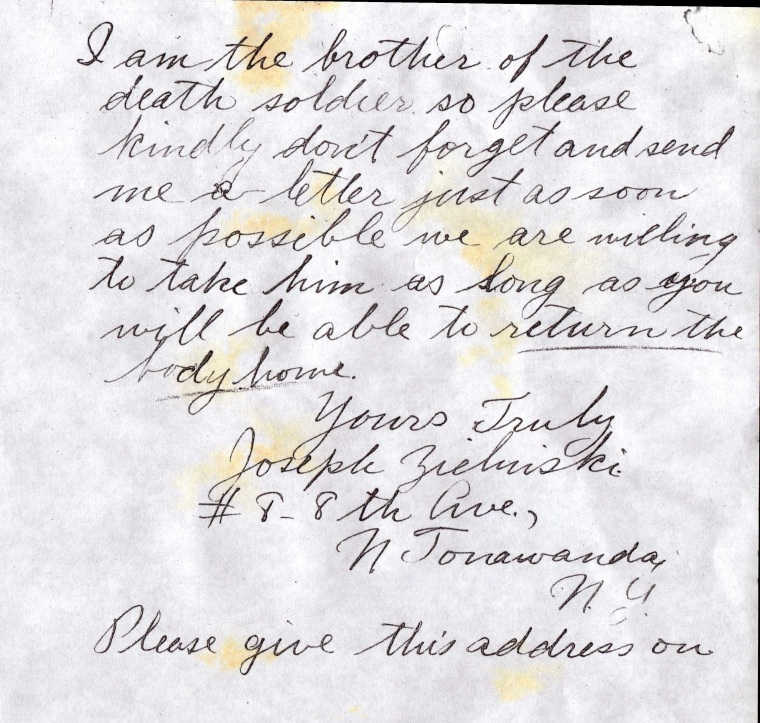
As the family flourished in the U.S., it continued to diminish in Poland. That autumn, on 30 September 1919, Joe’s 17-year-old sister, Władysława, died in Mistrzewice.7 Her death left only 22-year-old Władysław to manage the family farm and care for his aging mother, Marianna. However, eighteen months later, tragedy struck the Zieliński family in Poland once more, as Władysław Zieliński died on 23 March 1921, a few days after his 24th birthday.10 It’s difficult to imagine what a great loss this must have been for Marianna. She had borne 10 children, and 9 of them preceded her in death, including 8 children who died before the age of 30. Her only surviving son was living in the U.S., leaving her alone in Poland to manage the farm as a 64-year-old widow.
Władysław’s death was almost certainly the impetus for Joe Zielinski’s decision to move his family back to Poland. Although his uncle’s death was not mentioned by my grandfather, Grandpa clearly remembered traveling to Poland as a young boy, and living there for a period of time that he remembered as about 6 months. Their exact departure date is not known, but they were definitely gone by 28 April 1921. Additional correspondence from Frank Zielinski’s burial records file indicates that a letter sent to Joe Zielinski was returned on that date, marked “undelieverable” by the Post Office in North Tonawanda with the additional note, “Old Country” (Figure 9):
Figure 9: Copy of envelope returned to the Quartermaster General’s Office by the North Tonawanda, New York post office.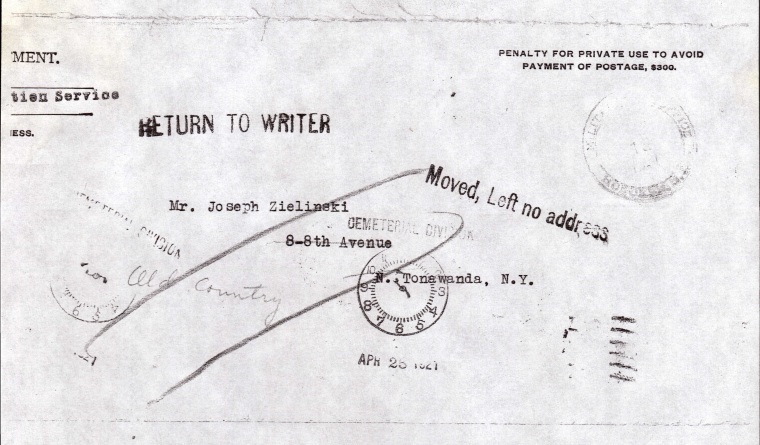
When they departed for Poland in the spring of 1921, Joe and Jenny’s family included 4 1/2 year old John, almost-3-year-old Frank, and baby Helen, born 2 August 1920. Jenny was also newly pregnant with their fourth child, Stanley Joseph (named after his paternal grandfather Stanisław and his father), who would be born on 11 November 1921. The family traveled on board the R.M.S. Olympic — sister ship to the Titanic (Figures 10a and 10b).
Figure 10a: Original postcard from the Zielinskis’ voyage to Poland, showing the Olympic.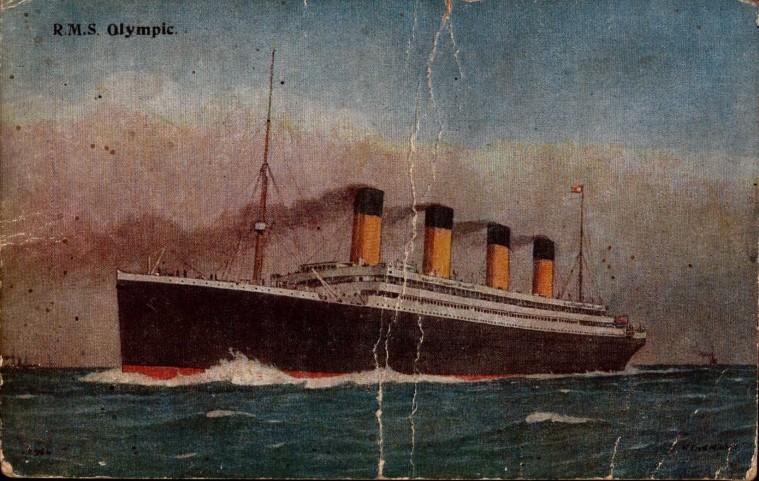
Figure 10b: Reverse of the postcard.
Although he was very young, my Grandpa vividly remembered certain experiences from the trip: tasting bananas for the first time on board the ship, chasing oranges that the sailors would roll across the ship’s deck for the children, and staring at all the soldiers’ helmets still lying in the creek behind his grandmother’s farm, a grim reminder of the recent war. He recalled riding in a horse-drawn wagon to the markets in Sochaczew and Warsaw. And he remembered his grandmother, Marianna, as a rather unkind woman. This impression was confirmed by Grandpa’s maternal cousin Julia Ziomek, who was three years older than he, and who shared with me her memories of conversations with her Aunt Jenny about that trip to Poland. Julia’s stories suggest that Joe and Jenny may have considered this as a permanent relocation. She recalled that Aunt Jenny had shipped packages of household supplies to Poland in advance of their journey, with the expectation that her mother-in-law would keep these things and have them ready for Jenny to set up housekeeping upon their arrival. Instead, Marianna deemed the items unnecessary, and donated them to the parish priest, which caused some consternation upon Jenny and Joe’s arrival. Cousin Julia also recalled Jenny’s comments about the unkindness of her mother-in-law to her children, scolding them harshly and calling them “dim-witted.” After only a few months, Jenny was ready to go back home to North Tonawanda, and apparently, Joe was persuaded. On 10 August 1921, my American-born grandfather entered Ellis Island with his family to resume the life they’d left behind.
Marianna Zielińska’s remembered harshness seems much more understandable in light of these new death records that tell the whole story of her suffering and loss. One can easily forgive a lack of patience with the children, given that she had just buried her ninth child when my grandfather and his family arrived in Poland. Perhaps she was embittered by so much loss and heartbreak, leaving her fearful of becoming emotionally close to her grandchildren. Perhaps Joe and Jenny tried to persuade her to sell the farm and return with them to North Tonawanda, and Marianna’s ill-temper arose from the stress of having to choose between her surviving son and her homeland. Although those details are lost, it is known that Marianna remained in Poland, moving in with her sister in Budy Stare. She died on 4 April 1936 (Figure 11).11
Figure 11: Death record from Młodzieszyn for Marianna Zielińska, 1936.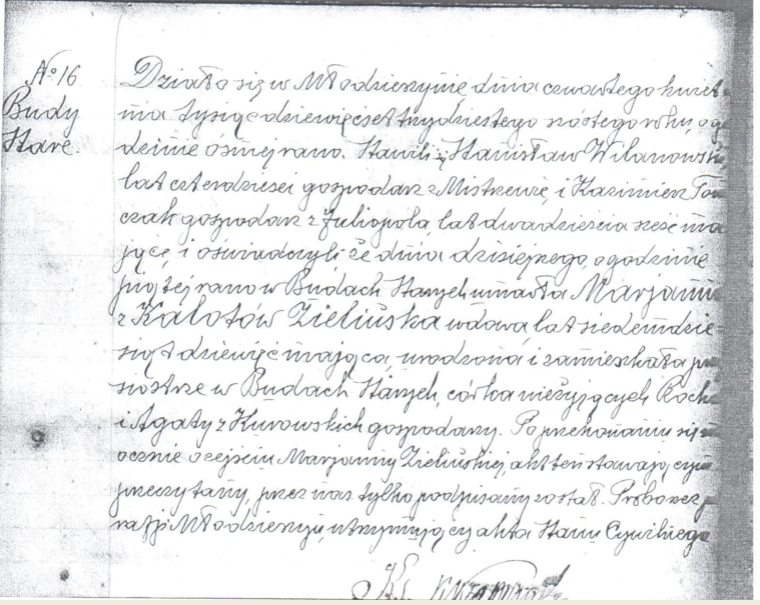 Translation:
Translation:
“No. 16, Budy Stare. It happened in Młodzieszyn on 4th April 1936 at 8:00 in the morning. They appeared, Stanisław Wilanowski, age 40, farmer of Mistrzewice, and Kazimierz Tomczak, farmer of Juliopol, age 26, and stated that, on this day today, at 5:00 in the morning, in Budy Stare, died Marianna née Kalota Zielińska, widow, age 79, born and residing with her sister in Budy Stare, daughter of the late Roch and Agata née Kurowska, farmers. After eyewitness testimony to the death of Marianna Zielińska, this document was read aloud to the witnesses but signed only by us. Pastor of the Parish of Młodzieszyn acting as Civil Registrar.”
Rest in peace now, Marianna. Your story has been told.
Sources:
Where possible, sources are linked directly within the text. Citations for sources not available online appear below.
1 Jonathan D. Shea and William F. Hoffman, In Their Words: A Genealogist’s Translation Guide to Polish, German, Latin and Russian Documents: Volume I: Polish, (New Britain, CT: Language & Lineage Press, 2000), p. 305.
2 Akta stanu cywilnego parafii rzymskokatolickiej w Młodzieszynie, 1903, #102, death record for Marianna Zielińska.
3 Akta stanu cywilnego parafii rzymskokatolickiej w Młodzieszynie, 1915, #101, death record for Stanisław Zieliński.
4 Akta stanu cywilnego parafii rzymskokatolickiej w Młodzieszynie, 1916, #78, death record for Szczepan Zieliński.
5 Akta stanu cywilnego parafii rzymskokatolickiej w Młodzieszynie, 1917, #20, death record for Jan Zieliński.
6 Report from Private Henry Davies regarding Frank Zielinski’s cause of death, Records of the Quartermaster General’s Office, 1915-1939, Burial Case File for Private Frank Zerlintski, serial number 1680271, Record Group 92, National Archives Identifier 595318, National Personnel Records Center, St. Louis, Missouri.
7 Niagara, New York, Naturalization Records, Declarations of Intent to Naturalize, #4244, record for Joseph Zielinski, 18 March 1919.
8 Letter from Joseph Zielinski to the Quartermaster General’s office regarding disposition of remains of Private Frank Zielinski, dated 13 March 1919, Records of the Quartermaster General’s Office, 1915-1939, Burial Case File for Private Frank Zerlintski, serial number 1680271, Record Group 92, National Archives Identifier 595318, National Personnel Records Center, St. Louis, Missouri.
9 Akta stanu cywilnego parafii rzymskokatolickiej w Młodzieszynie, 1919, #75, death record for Władysława Zielińska.
10 Akta stanu cywilnego parafii rzymskokatolickiej w Młodzieszynie, 1921, #24, death record for Władysław Zieliński.
11 Akta stanu cywilnego parafii rzymskokatolickiej w Młodzieszynie, 1936, #16, death record for Marianna Zielińska.
© Julie Roberts Szczepankiewicz 2017


I LOVE THE WAY YOU WRITE AND TELL YOUR FAMILY’S STORIES. YEARS AGO I THOUGHT THAT I WOULD PULL THINGS TOGETHER TO MAKE IT INTERESTING – BUT ALAS – DID NOT AND WILL NOT HAPPEN. THANKS FOR SENDING TO ME. BONNIE
From: From Shepherds and Shoemakers To: justmomfor5@yahoo.com Sent: Friday, April 7, 2017 7:42 AM Subject: [New post] The Sad Tale of the Zieliński Family of Mistrzewice #yiv3071917232 a:hover {color:red;}#yiv3071917232 a {text-decoration:none;color:#0088cc;}#yiv3071917232 a.yiv3071917232primaryactionlink:link, #yiv3071917232 a.yiv3071917232primaryactionlink:visited {background-color:#2585B2;color:#fff;}#yiv3071917232 a.yiv3071917232primaryactionlink:hover, #yiv3071917232 a.yiv3071917232primaryactionlink:active {background-color:#11729E;color:#fff;}#yiv3071917232 WordPress.com | Julie Roberts Szczepankiewicz posted: “”Happy families are all alike; every unhappy family is unhappy in its own way.” — Leo Tolstoy, Anna KareninaStanisław Zieliński was born on 6 April 1863, the third child and oldest son of the known children of Michał Zieliński and Antonina Ciećwierz. H” | |
LikeLiked by 1 person
Hi Bonnie! I’m so glad you enjoyed the article. Thanks for your kind words. From what you’ve told me, you’ve gathered together an impressive legacy for your children and grandchildren in research, photos, and heirlooms which you’ve taken care to preserve and organize. That’s quite a gift, even if you never do write any sort of narrative to go with it.
LikeLike
I,m a Zolinski and some of these name sound like names that have come up in family searches so wondering if this is also my family history, Kasmir, joseph, marianna, zophia, frank, stanislaw, Michal all names that have popped up. So much death has come upon my present family generation so no parents, grandparents to help me to locate or even talk about our history. My grandparents were Michael and Maria Zolinski (Zielinski(a).
LikeLike
Hi Lisa, Zoliński is a valid, though rare, Polish surname in its own right, separate from Zieliński. https://nazwiska-polskie.pl/Zoli%C5%84ski
No matter what the original surname, you can trace their history through documentary research, even if no family stories remain. If your grandparents were alive in 1940, for example, you can find them in the 1940 census, and then trace back from there. This blog post walks you through the process: https://fromshepherdsandshoemakers.com/2018/03/12/a-beginners-guide-to-polish-genealogy-revised-edition/ Good luck! By the way, the Polish versions of the names you mentioned would be Kazimierz, Józef, Marianna, Zofia, Franciszek, Stanisław, Michał, and Maria (or Marianna). In English-language records, you might see Casimir (or Casey), Joseph, Marianna (or Marie, Maria, or Mary), Sophie or Sophia, Frank, Stanislaus (or Stanley), Michael, etc. Good luck and have fun! 🙂
LikeLike
Julie, I love to read all the details in your stories. You have been given so much history and you synthesize it so well. I was really touched by the reasons for Marianna’s harshness. Such a sad way to end life.
LikeLiked by 1 person
Thanks, Donna. I was so saddened to find all those death records for Marianna’s children recently. I felt compelled to tell her story, and I felt like I came to understand her so much better through the documents.
LikeLike
You bring to life the stories of your family members who lived so long ago. I am in awe of your ability to take facts and compose an interesting story of their lives. Thank you.
LikeLiked by 1 person
Thank you so much, Jan! Those of us who research our family histories feel a connection to our ancestors, which I’m sure you can relate to. Sometimes it feels like their stories just need to be told.
LikeLike
Julie, your talent for bringing life to history is enviable. I do so enjoy your posts.
LikeLiked by 1 person
Thank you so much, Joe!
LikeLike
I so enjoy reading your work – your writing gives life to people long gone and helps me understand a bit about their stories, about history, about how families evolve. The number of children who did not survive their early years is so sad and I can understand how a woman might fear allowing herself to be close again after this happens to her. I was fascinated by your explanation (and valuable footnote) about the word “gospodarz” which I have seen in ancestors’ records, I had thought it meant only farmer, and I did not understand its fuller meaning. I thought it might include serfs or others who did not own land. Do you know if there a similar word with such an implied meaning in Russian? Google translates says хозяин. If that is it, do you know what it looks like in script? Thanks.
LikeLiked by 1 person
Thanks, Vicki! The Russian word хозяин is defined by Shea and Hoffman as kind of a catch-all, “master of the house, owner; husband, man,” but in my experience, if a man was described as a gospodarz prior to 1868 he’ll be described as a хозяин after 1868. Steve Morse has a Russian print-to-cursive tool that will give you an idea of what this word will look like in cursive: http://stevemorse.org/russian/cyrprintcurs.html?font=print
By the way, I strongly recommend all of Shea and Hoffman’s genealogical translation guides, but especially their Russian guide, if you want to get serious about Russian translations. You can read more about it here: http://langline.com/ITW_Russian.htm
LikeLike
Thanks so much for the leads Got it now!
LikeLiked by 1 person
A great, yet sad, story, Julie! The tale of Marianna and her family was well told. You’re inspiring me to dust of my blog again.
LikeLiked by 1 person
Thank you so much, Donna! Your blog is a classic — I hope you do decide to dust it off and write more posts!
LikeLike
Thank you for writing the story of these immigrants who left Poland for a better life. What heartbreak they all suffered. I am searching for my ancestors in Russia/Poland, also. I just need more time to follow up on them. Keep up the good work.
LikeLiked by 1 person
Thank you, Barbara! Good luck with your research!
LikeLike
Wow – this story is truly heart-breaking. How awful for your great-great-grandmother to lose all those children. And how difficult for your great-grandfather, who must have felt like he was choosing between his wife/children and his mother. I know how close Polish men remain to their matkas, no matter their age. Your writing is so very compelling.
LikeLiked by 1 person
Thank you! 🙂
LikeLike
Reading this was enlightening to me. It’s also a reminder to be kind to our elders, who may not appear kind themselves. My mother has similar stories of her grandmother, born in gmina Stubno, and how she would chase them and call them names or slap them. This sort of story doesn’t seem uncommon! As I looked more into the circumstances which likely caused them to immigrate, I can see that they may have been very sad people.
LikeLike
I totally loved reading this account of your family history.
LikeLiked by 1 person
Thank you so much! That’s so kind of you.
LikeLike
Hello! I have been trying to gather information on my family for a long time! I’m glad I found this article! I’m pretty sure Helen was my great grandmother!
LikeLike
Hi Megan! I’m glad you enjoyed the article! Do you mean Helen Zielinski, daughter of Joseph Zielinski and Genevieve Klaus? I’d be really surprised if she were your great-grandmother, because she died of tuberculosis in 1948 before she ever married. Zielinski is a very popular Polish surname. Can you tell me more about the Helen Zielinski that you’re looking for?
LikeLike
Oops, maybe I’m thinking of someone else. My great grandmothers name was Helen Hilda Zilinski (1922-2006), she was the daughter of Walter Zilinski (1889-1978) and Bromstawa Racnynska who was born around 1896. I don’t know much information about other then that she’s from Poland. My great grandmother had a brother named Frank, who does at a couple days old, and a sister Sophie Ann, I’m not sure if there are any other siblings.
LikeLike
Hi Megan, are you on Ancestry? There’s a family tree there that includes your family members, here: https://www.ancestry.com/family-tree/person/tree/33316848/person/18487594941/facts
Please note that some of the names are misspelled. Helen’s mother’s name was Bronisława Raczyńska (the masculine version of the surname would be Raczyński, but her surname ends in “a” because she’s a woman) and her husband’s name was Władysław Zieliński. I haven’t gone through all the data in that person’s tree to be sure that I agree with her conclusions, but I’d get in touch with her and see if you can work together to trace your family. There are some additional suggestions for tracing immigrant ancestors here: https://fromshepherdsandshoemakers.com/2018/03/12/a-beginners-guide-to-polish-genealogy-revised-edition/
You can also get assistance through any of the Facebook groups dedicated to Polish genealogy. I’m an admin for Poland & Genealogy, here: https://www.facebook.com/groups/polandandgenealogy and also the Galicia Family History Group (which covers the Galicia region, which occupies what is now southeastern Poland and southwestern Ukraine): https://www.facebook.com/groups/GaliciaFamilyHistory Good luck! 🙂
LikeLike